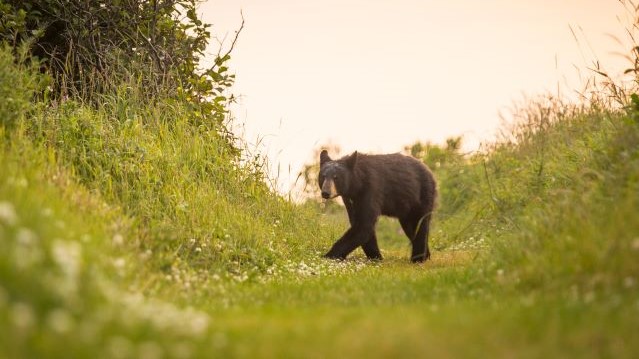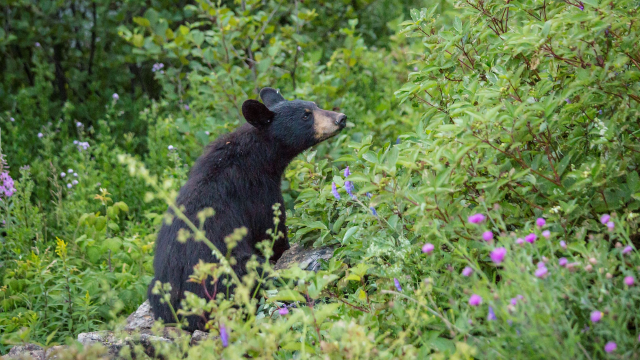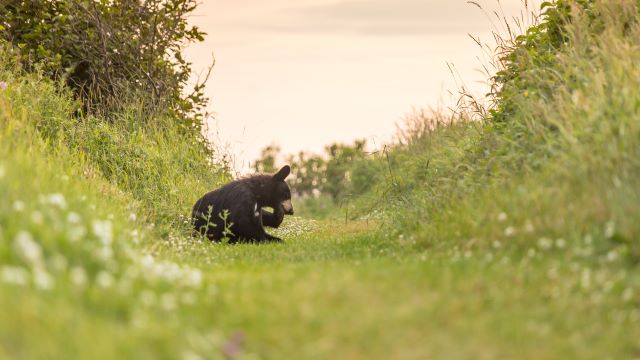
The black bear prefers the forest to the open areas.
How to react if you encounter a black bear
Forillon National Park
There is no single, short answer that will work in all types of encounters, but the following advice could come in handy.

Stay calm, even if that may seem difficult. By remaining calm, you will be able to keep control and make better decisions. It may also reassure the bear and lower its stress level – which is what you’re aiming for!
Talk calmly to the bear. It isn’t silly to talk to a bear! When it hears your voice, it will know that you are a human. And since the black bear thinks you are stronger than it is, there’s a very good chance it will leave. What’s more, talking to the bear will help you to stay calm and in control, which is no small matter!
Take children into your arms and stay together as a group. This helps to make you appear bigger and impress the bear.

Analyze the situation to determine which behaviour is the best to adopt in the situation. Was the bear surprised to see you? And so on.
Never approach a bear. Even a bear that looks “inoffensive” to you can become aggressive if it feels threatened when you get close to it. As much as possible, you should always keep a distance of at least 100 metres between yourself and a bear – i.e., the length of five school buses put end to end.
Never run when you encounter a bear. You risk triggering a chase, and no human stands a chance of outrunning a bear going either uphill or downhill.

Never turn your back on a bear. Always move away sideways or backing away, keeping an eye on the bear at all times.
Do not drop your backpack. It could protect you in the event of an attack.
If despite everything you find yourself fairly close to a bear, give it room and make sure you allow it as many open escape routes as possible (i.e., do not block its path). If you are hiking in a group, never surround a wild animal but instead assemble in a way that does not give the bear the impression that it is cornered.
Different scenarios of black bear encounters
Every encounter with a black bear is unique and, in the vast majority of cases, becomes a pleasant travel anecdote. However, you should be aware that several scenarios are possible.
In the few examples that follow, we suggest some safe ways of dealing with the presence of a black bear.
The bear did not see you
If the bear did not see you and continues to go about its business, move away slowly and quietly, while also keeping an eye on the bear. Make a wide detour around the bear, even if that means coming back to this area once the bear has left.
The bear stops and looks at you
If the bear stops and looks at you, stop where you are and do make any sudden moves. Talk to it calmly with a normal voice (do not yell). For example, you can tell it that you are a human but that you do not wish to do it any harm. If the bear has trouble seeing you, it will rise on its hind legs and try to detect your scent and thereby identify you. Do not panic – this is not a sign of aggressiveness.
The bear simply wants to know who is in its surroundings. Once the bear has recognized you as a human, there’s a good chance that it will move on.
If the bear does not leave, move away slowly while continuing to talk to it calmly and to look at it (do not turn your back to it). Leave the area in the same direction you came from or make a wide detour around the bear in order to continue your hike.
The bear stands on its back legs
The black bear has a very developed sense of hearing (which is more effective than its sense of sight).
As a result, the bear will attempt to point its snout into the wind and will stand on its back legs to better see and smell what is going on around it.
While the sight of a bear standing upright may be impressive, it should not be interpreted as a sign of aggressiveness or an indication that it wishes to attack. It means only that the bear has detected someone or something in its environment.
Once the bear has recognized you as a human, there’s a good chance that it will move on.
If the bear does not leave, move away slowly while continuing to talk to it calmly and to look at it (do not turn your back to it). Leave the area in the same direction you came from or make a wide detour around the bear in order to continue your hike.
The bear has seen you, looks at you, and continues to go about its business
The bear has seen you, looks at you, and continues to go about its business, move away slowly. Make a wide detour around the bear, even if that means coming back to this area once the bear has left.
This situation may occur whenever a bear has learned to trust humans. In a protected territory, bears get used to seeing unthreatening humans. This “human habituated” bear has not lost its fear of humans but feel sufficiently secure to pursue its activities even when a human is in the vicinity.
However, you must not interpret a bear’s seeming indifference as an invitation to approach it. Never approach a bear. Regardless of whether it is “habituated” or not, a bear that feels intruded upon can become stressed or aggressive. The distance at which a habituated bear will tolerate humans varies according to each bear. Some bears have a personal space around them that is smaller than that of other bears – the same as with humans. In short, whenever you see a bear, you must move away from it, regardless of whether it appears to be habituated or not.
It is important to recall that a “human habituated bear” is not a “human food-conditioned bear.” However, since a habituated bear does not necessarily avoid humans, it is more likely to be exposed to inappropriately stored food.
A “food-conditioned” bear is one that has developed an association between humans and an easily accessible source of food. Ultimately, this type of bear will overcome its fear of humans, and will seek food sources that people voluntarily or inadvertently supply it with.
The bear has been startled
No one likes to be caught off guard. Think about how you feel whenever someone startles you.
In a situation of this kind, the bear may show aggressiveness, thinking that it has to defend itself from you. It has become stressed by your sudden arrival. At that point, is very important to make it understand that you do not intend to harm it in any way.
Talk softly to it (by all means do not shout) and back away slowly, without making any sudden movements, all the while keeping an eye on it.
It is crucial to make the bear understand that you are not a threat to it.
The bear is in a tree
Move away slowly and quietly, while also keeping an eye on the bear.
Make a wide detour around the bear, even if that means coming back to this area once the bear has left.
It if looks at you and becomes agitated, talk softly to it while backing away.
If it is a cub you see, it is highly likely that its mother is not far from the tree. Stay on the lookout as you move away.
A cub, or a mother bear with its cubs
Whenever you see a cub, stay on the lookout and leave the area quietly.
Even if you don’t see the mother bear, know that she is not far away. Moreover, it won’t be long before she catches sight of you, if she hasn’t done so already.
Females are protective of their little ones.
If the mother sees you, it is very likely that she will fear for her cubs and become very stressed (see signs of stress).
Be as unthreatening as possible (no sudden movements and no shouting), and move away calmly, while keeping an eye on the mother black bear’s behaviour.
The bear is moving toward you
The black bear has seen you and starts moving toward you
The bear moves toward you and shows signs of stress, this is the case of a bear exhibiting defensive behaviour. This means that you have entered the bear’s "personal space", and it fears for its security and that of its cubs (in the case of a mother bear)
How to react if a defensive bear moves toward you or charges you: you must remain stationary and stand your ground. You must avoid shouting and you must refrain from throwing anything at the bear.
When a defensive bear charges someone, it usually stops before reaching the person (this is called a bluff charge). The bear is trying to intimidate you.
Once the bear has come to a halt, resume moving away and talk to the bear calmly so as to reassure it. This should help the bear to calm down and allow you to leave the area.
During a bluff charge, bears frequently veer off and then flee.
Bluff charges are rare, and most often result from someone trying to get too close to a bear. If you keep a good distance between yourself and a bear and refrain from approaching it, a bluff charge is very unlikely to occur.
If a black bear attacks
An attack is said to occur whenever the bear comes in contact with you. If the bear has, or is about to, come in contact with you, play dead. (Before it reaches you, you can also use bear spray, assuming you have some on you and that conditions lend themselves to using it.)
A defensive bear is not seeking to get into a fight or to feed itself. The only thing the bear wants is to put a stop to the threat. Once the bear sees you lying immobile on the ground, its stress should diminish when it realizes there is no more cause for its stress.
How to play dead
Lie flat on your stomach, spread your legs apart and place your hands behind your neck.
Remain quiet.
If the bear manages to turn you over, quietly roll back onto your stomach.
In this kind of situation, a backpack can be very handy for protection purposes.
Once the bear is reassured that it has nothing to fear from you, it will move on.
Before you get up, wait until the bear has truly left the area (remain lying without moving, 30 minutes if necessary). If you get up while the bear is still there, it will think that you want to fight and could try to immobilize you another time.
This type of attack usually lasts several minutes at most. However, if the bear persists and continues to attack you, you will have to change tactics. It may have decided that you would make a good meal. In that case, you will have to stand up and fight. Use everything you can to hit it (e.g., fists, feet, sticks, rocks, etc.).
But remember that this type of attack occurs only very rarely.
The predatory bear is the most dangerous kind of bear. However, initially its behaviour will not come across as being threatening to you. It looks calm and advances without growling. It will stare intently at you, like a cat focused on a mouse – and that should trip alarm bells in your head.
In contrast, the defensive bear will growl, “pop its jaws,” drool and slap its feet on the ground. All in all, its behaviour creates a bigger impression, and yet this is the type of bear that you need fear the least.
The predatory bear is usually a male. It is the type of bear that follows people on a trail or attacks them in their sleep. Remember, however, that predatory bears are extremely rare.
Statistically speaking, you are 350 times more likely to die from a lightning bolt than from a bear attack.
The bear moves toward you calmly
You are dealing with a non-defensive bear.
It approaches hesitatingly, with its snout pointing upward in order to catch your smell and identify you. It may be that you are dealing with a bear that is merely curious.
How to react
- Stay calm and talk to the bear in an authoritative tone.
- Get out of its way (the bear perhaps only wants to continue on its way).
- Show confidence – this may persuade the bear to stop advancing.
If the bear stares at you intensely while quietly but actively stalking you (showing no sign of stress), you are dealing with a predatory black bear and are in danger!
How to react
- Stop moving, stand up to it and be aggressive.
- Do everything you can to intimidate it: make yourself look bigger, stand up on top of a rock, wave your arms or a branch over your head, yell, stamp your feet, and use your bear spray, if you have any on you.
- You must make the bear understand that you are a ferocious adversary and that it should think twice about getting into a fight with you.
- The predatory bear is not seeking to defend itself but to eat you.
- If you fight back with every fibre and ounce of strength in you, you stand a chance of making the bear back off.
If a NON-defensive bear attacks, defend yourself! Do not play dead. The predatory bear is not seeking to defend itself but to eat you. You must fight in order to save your life.
Use whatever you have to hit it (fists, feet, sticks, rocks, knife, etc.) and aim for sensitive areas, like the nose and eyes.
You must quickly show the bear that it is at risk of being seriously injured or even killed in a fight. The bear must understand that you will not surrender and that it must give up on getting into a fight with you!Do not forget to shout, as someone could be close by and able to come help you.
If you are in a group, stay close together and act together.
- Date modified :